
West German Navy’s flagship
In this day of Germany Unity (3 October) what more but the very flagship that bore the country’s name, Ambassador and flagship of the Bundesmarine for most of the cold war ? A59 Deutschland though was not a capital ship, but a schoolship (A for auxiliary in NATO classification), with the vital duty to train recruits of the new German Navy to the latest weaponry and electronics standard, in the NBC and Atomic age. They notably trained the crews of the upcoming Lütjens and Hamburg class destroyers, Köln and later Bremen class frigates, the bulk of the fleet’s strenght at sea. She was indeed ordered as the fleet went into a considerable military upgrade and a dozen ships planned, that needed crews. She also represented the fatherland during her long cruises around the world, a marine ambassador, still vividly remembered by its crews and trainees.
Genesis of A440 cruiser Deutschland
Third of the name, after the last German pre-dreadnought class and famous 1930 cruisers, this one was designed in a dual role: A large frigate able to perform multi-role missions and full military duties with the fleet in wartime, with all the equipments and weaponry awaited fro this type, and as a schoolship in peacetime.
This “Schulschiff Kreuzer” however was given indeed many extra missions, such as troop ship, hospital ship, minelayer, and escort, for which specific accomodations and equipments had to be provided. The design was also to be very modular to reach these goals. The large onboard accomodations helped in this, because in order to prepare cadets for the active fleet, she was to represent the wide array of contemporary armament and machinery fitted in Bundesmarine Frigates, chief of which were the contemporary Hamburg class.

Poster of the Bundesmarine. Given her importance, FGS Deutschland is front and center.
Detailed design of FGS Deutschland
In her time Deutschland was the largest vessel in the navy of the Federal Republic of Germany. Permission to build a ship of that tonnage had to be asked for, and granted by NATO as she was above the tonnage restrictions imposed on West Germany. Later the Berlin class replenishment ships of the reunited Germany would be much larger. Anyway, she was the largest ship projected by the Bunesmarine at that time, and like most ships of her generation, she was completely NBC protected. If considered a “cruiser” she was however equivalent to the 4,385-ton SMS Brummer and Bremse of 1915.
Hull & general construction
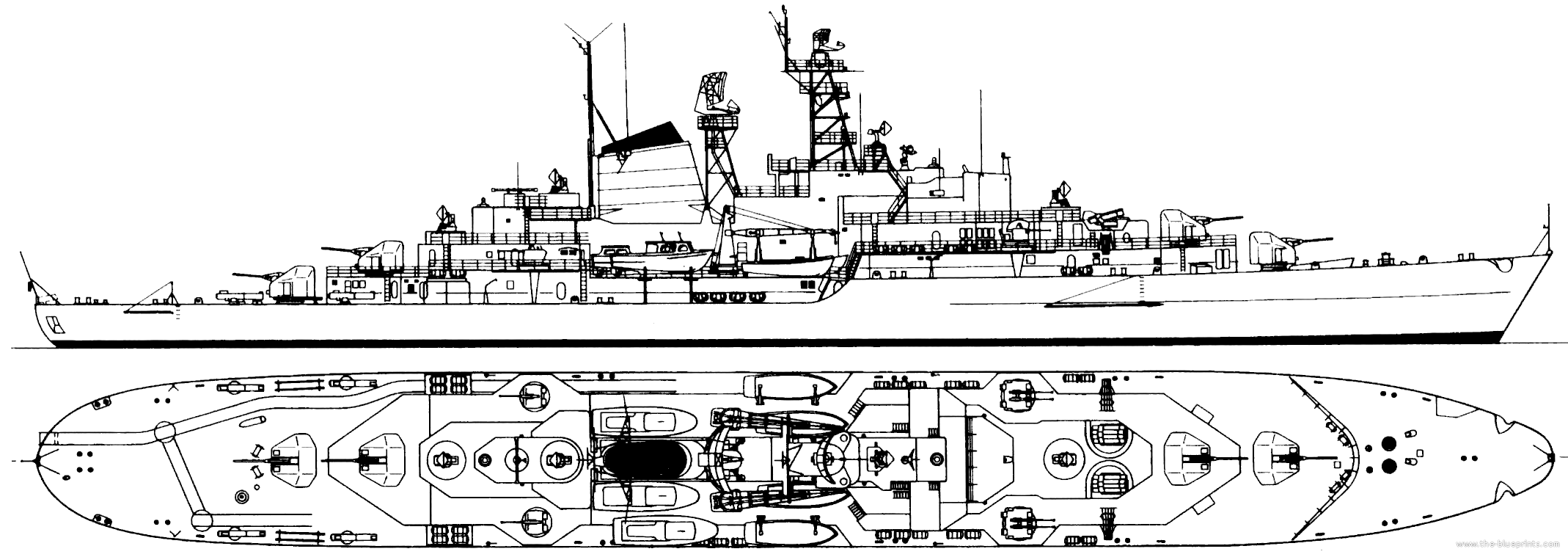
The first striking trait of this unique ship, after her record size, was her hull and general appearance. Like the Hamburg class destroyers, she was “pretty busy” on the superstructure standpoint, and had the same “full lines” hull (meaning the greater beam was reached soon for the upper hull lines and the greater lenght was rectangular). But comparisons stops here as FGS Deutschland also had a classic forecastle hull, anticipating the problems with the Hamburg class with their low flush-deck hull, quite wet in heavy weather. The forward hull had some flare but the same line break as on British ships, and a large, rounded poop.
The superstructures were quite intensive, on five deck, from the aft weather deck, with a single, very large funnel aft and large bridge superstructure, with an on deck. Electronics were supported on the bridge’s roof and on a lattice formast mast, followed by a shorter lattic mainmast sypporting the large aerial. Armament was also more extensive, albeit classic with four artillery turrets, in fore and aft superfiring pairs. No missiles apart ASW rocket launchers and AA artillery, plus torpedo tubes. She also had 3 anchors, one aft, two fore.
FGS Deutschland’s displacement was 4.880 tons Standard as designed, and 5.684 tons fully loaded, so almost 900 tons more than the Hamburg class destroyers. She only was a bit longer at 138,23 Meters versus 133.70, but three meters larger at 16,05 m versus 13.40 m, but had a lower draught of 4,50 Meter (versus 4.80, but rose to 5,28 with the Sonar). She carried a crew of 30 Officers,
30 and 90 lower ranks officers, 180 cadets/crew and 120 instructors, plus 6 civilians like the captain’s steward, a shoemaker, a tailor serving alongside military personnel. (Other sources gives 172 officers and men, 120 cadets). To save them, she had seven service boats, three to four motor cutters and three fast pinnaces with two cranes to manage them with a 160° arc, along the superstructure between the mainmast and funnel. She also had 30 inflatable life rafts strapped along the gangways. Under deck, she had comparably large teaching rooms and other facilities which could be converted quickly to act as troop carrier, hospital ship or minelayer (see later).
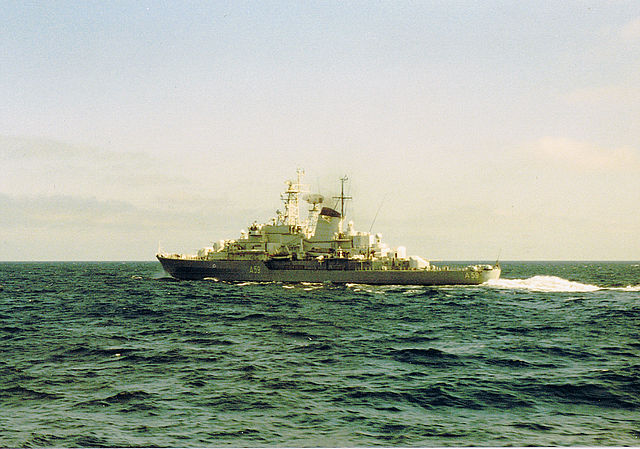
A59 at full speed, 1970s
Machinery
The machinery was rather diverse ahd she had two pairs of different diesel engines and a steam turbine combined.
Performance-wise, emphasis had been laid on range rather than speed. This mixed propulsion system corresponded to the propulsions systems available at the time, reflecting the current destroyers and frigates equipment under under construction. The machinery general scheme closely followed that of the Hamburg and Rhein class.
–Four MTU diesel rated for 2000 hp each,- outer shafts.
–1 steam turbine connected to two WAHODAG high-pressure superheated steam boilers rated for 8000 on the central shaft.
Each shaft shaft had an Escher Wyss controllable pitch propeller. Total output 16,000 hp (12,000 kW).
Deutschland could reach 16 knots on the diesel alone, and 21 knot top speed combining all three, for a range of 3,800 nm at 12 knots in economic cruiser, down to 1,700 nm at 17 knots. In comparison the Hamburg class desroyers had two shafts, for a total output of 68.000 hp, reaching 35 to 37 knots max, but at half the range in cruise speed.
Armament
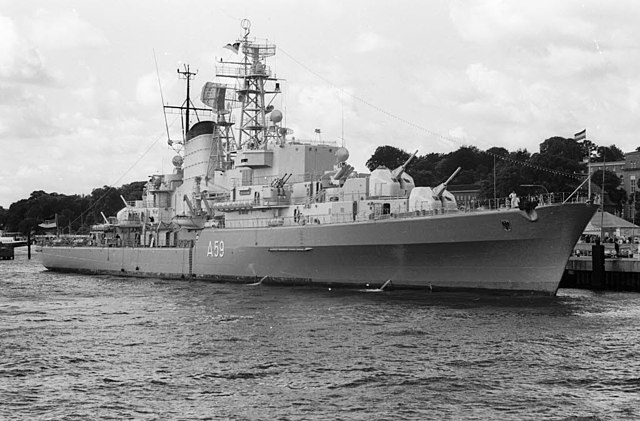
A59 in Kiel, 1982, showing her main armament, which fundamentally stayed unchanged until 1989, but was completely obsolete by that time.
It was essentially a repeat of the Hamburg class destroyers, with some differences and additions:
-Four Creusot-Loire 100 mm/L55 Dual-Purpose Guns. Same as the French models (see specs)
-Two Breda 40 mm/L70 Twin mount, under shields, on sponsons on the forward superstructure’s roof.
-Two Bofors 40 mm/L70 Single mount aft, on platforms and in turret-like open structures
-Two quadruple Bofors 375 mm ASW Rocket Launchers forward, side by side, after “B” turret.
-Four 533 mm (21 in) Torpedo Tubes, with dual purpose homing torpedoes, non-reloadable, on single mounts aft, alongside turret “Y”.
-Two fixed TTs aft, removed in the 1970s.
-Two depht charges racks at the poop with WaBo (Wasserbombe) of the 1950 type.
-Two Mine Rails, about 75 m in track length with a throwing point aft.
A few remarks: The 100 mm were the 55 caliber model 53. The Bofors and Breda were of the same caliber and barrel lenght, and operated about the same way.
Electronics
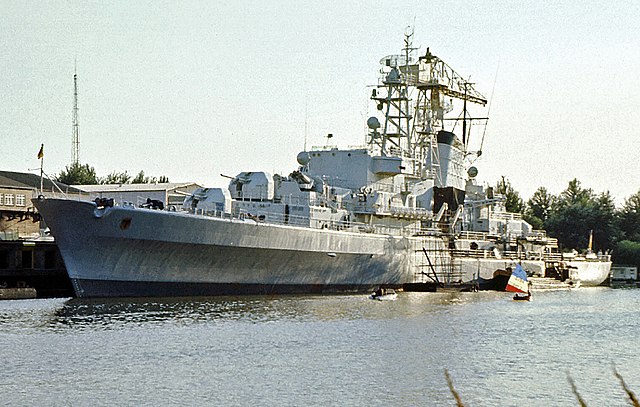
A59 in W. Rendsburg, 1972, showing her lattice masts and aerial.
She carried a LW-08 aerial first warning and search radar, an SGR-114 and SGR-105 as well as SGR-103 fire control radars, and an M-45 Sonar underbelly, which could be lowered in place and retracted given the service depth.
Construction and specifics
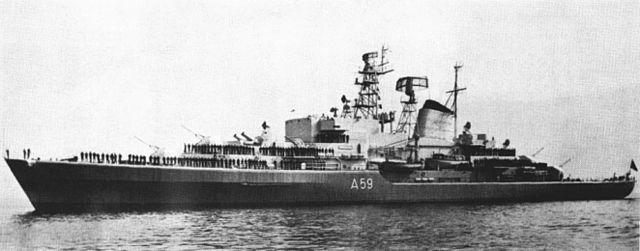
Deutschland off Pearl Habor, 1965, for her first circumnavigation.
The new ship, Type 440 in the German designation system, was commissioned in autumn 1958, costing German taxpayers of the time the record DM 95 million (approx. EUR 48.5 million). She was laid down on September 11, 1959 at Nobiskrug shipyard, Rendsburg (On the Kiel Canal). A good year later, on November 5, 1960, she was launched in presence of Federal President Heinrich Lübke, His wife (Wilhelmine Lübke) christening her. Initially “Berlin” was considered by dropped due to objections from the Allies.
She was commissioned on May 25, 1963, with Defense Minister Kai-Uwe von Hassel in attendance as well as the Inspector of the Navy, Vice Admiral Karl-Adolf Zenker. The latter was the son of Reischmarine admiral Hans Zenker, and commanded destroyers in WW2. The class 139 school tenders used to that point, Eider and Trave, were reassigned by July 1963. Her first captain was Herwig Collmann, from May 1963 to July 1965, but there was none from July 1965 to September 1965 for post-service fixes. Then Sea Captain Burkhard Hackländer took office, from September 1965 to Sept. 1966.
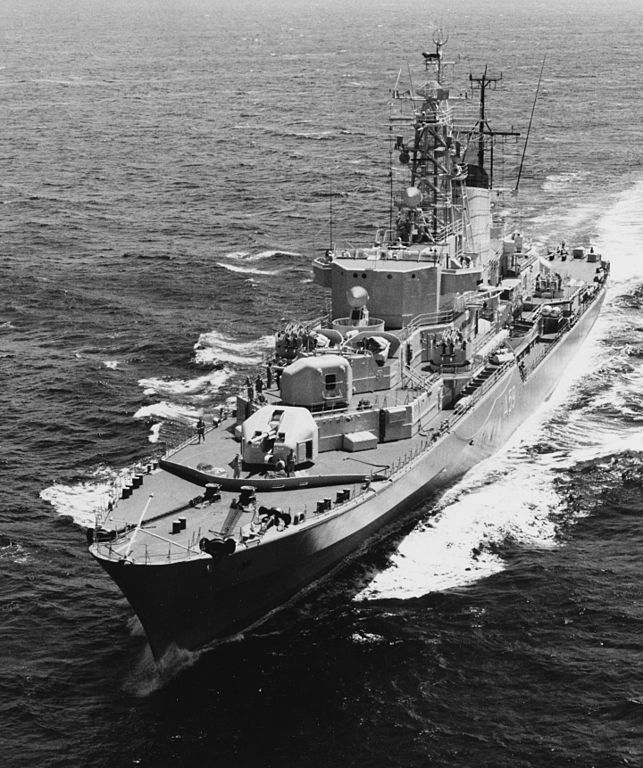
A59 off the Hawaiian coast at full speed, 1974
Role and organization
Like the sailing ship Gorch Fock, the “classic” cadet ship since (former one was given as war reparation to USSR, a new one was just launched in 1958), FGS Deutschland was initially subordinated to the training command. From 1966, she was subordonated to the Mürwik Naval Academy, in Flensburg-Mürwik. Her task was to deepen the education at sea of the officer candidates (OA) bringing them to the next grade and validate their theoretical knowledge by in-condition practical onboard operations. Officer candidates also had to be confronted by weather conditions on high seas and particular living conditions on board.
The crew, led by the commander and his deputy the first officer, was divided into the following departments, called “divisions”::
-1st: Naval weapons and deck service led by the Ship Weapons Officer, 1st Artillery Officer and Artillery Weapons Control Officer.
-2nd: Ship Technology: With Ship Technical Officer, Safety Officer, Electrotechnical Officer, Propulsion Officer in charge of the onboard systems and propulsion.
-3rd: Ship Operations and its chief Officer, the Navigation, Location, Communications, Command Electronics Officer and Meteorologist for long cruises.
-4th: Ship “supply” with the lead Supply officer, personnel, doctor, dentist, but also a Catholic and Protestant military chaplains fo long cruises.
-The “K” Division (For “Kadet”) which was the training division with a cadet officer, platoon officers and blocked weapons officer for instruction, also for long cruises.
Gallery
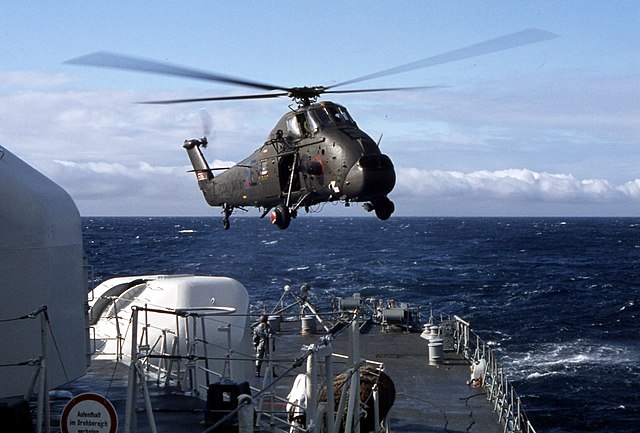
There was no hangar onboard, but to ease cadets with heli-operations in all weather and conditions, if there was no helipad aft, exercizes (like transport, supply and evacuation) were made with the Westland Wessex, like here.
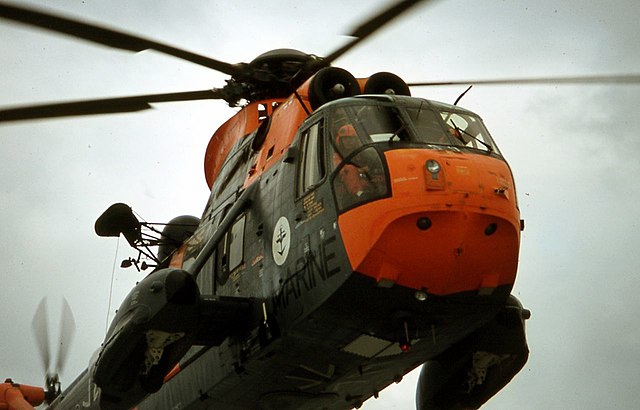
In the early 1980s, the old Wessex was replaced with the air branch of the Bundesmarine by the Westland Sea King, and operated in coordination with Deutschland for ASW warfare exercizes in the Baltic, or directed in SAR operations.
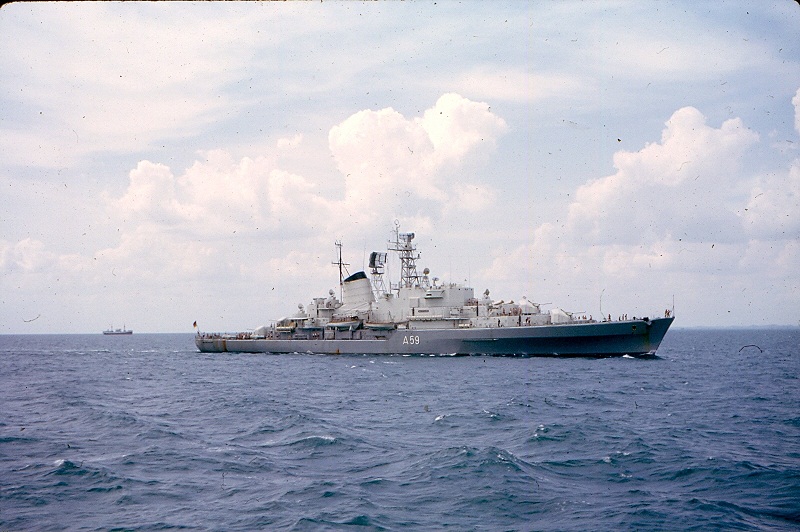
FGS Deutschland In 1965
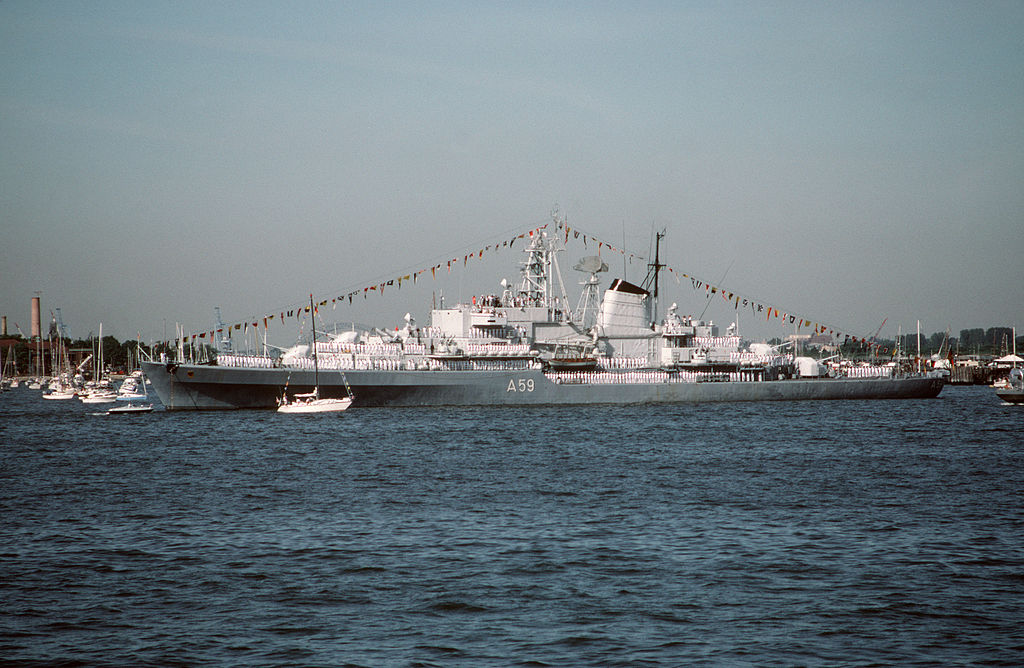
FGS Deutschland In 1986
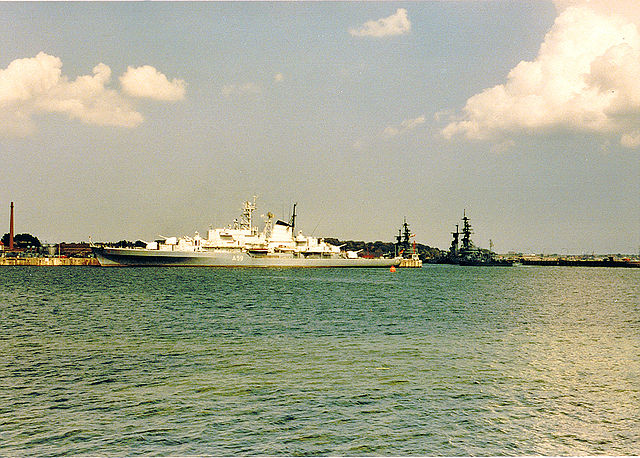
At the Tirpitz mole, 1980s
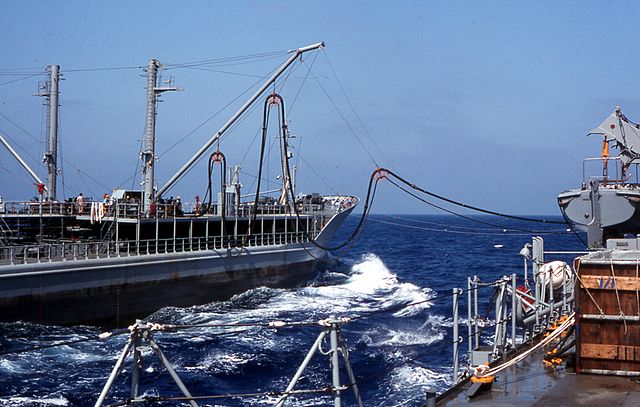
Supply at sea in the Mediteranean, off Great Syrta.
Career of FGS Deutschland
Early Cruises:
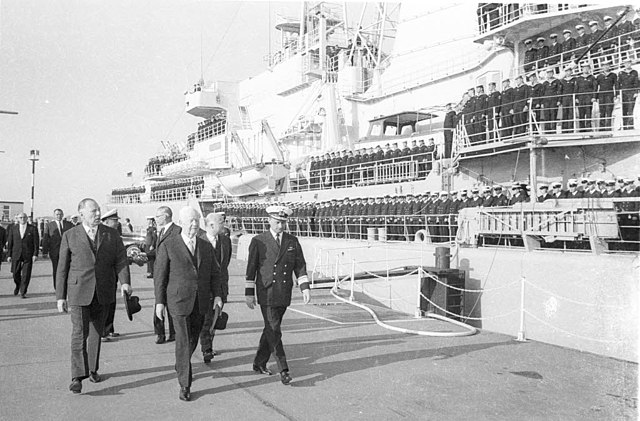
Kiel Week 1967, A59 is visited by the prime minister of the time.
Before her first long training cruise, FGS Deutschland departed for three test cruises, of shorter span: The first was around Great Britain in August 1963. It was followed by warm water trials until March 1964 in Gibraltar, Monrovia, Abidjan and Santa Cruz de Tenerife. It was followed logically by the cold water cruise, from April to June 1964 in Norwegian waters, based in naval base Haakonsvern. But for all this time, the ship’s main base and home port was Kiel. All cruises started from there and ended there.
On January to June 1965 started her first world cruise. She sailed to Gibraltar and took the Suez Canal via Port Said, reached Aden and from there, stopped in Cochin, Manila, Tokyo, Osaka, Honolulu, San Francisco, Panama canal (via Rodman Station), Cartagena and Ponta Delgada, then Brest in France before return to Kiel. Next year in 1966, until June, she made her first south american cruise, sailed to and from Dakar to cross the Atlantic, reaching Santos, calling Puerto Belgrano, Valparaíso, Guayaquil, and then going through the Panama canal to La Guaira, and Funchal on Portugual before going home. In September, Captain at sea Ulrich Rehdertook command for a year, followed by Captain Karl H. Peter until December 1968.
The next January-June 1967 cruise was back to North America (Ponta Delgada, Charleston, Houston, Panama Canal, Balboa, San Diego, Vancouver, Mazatlán, Panama, New Orleans, Hamilton). 1967 cruise was shorter and focused more on the Caribbean, February-May 1968 (Funchal, Salvador da Bahia, Fort-de-France, Kingston, Ponta Delgada), followed by an August-December cruiser to Las Palmas, Accra, Rio de Janeiro, Salvador da Bahia, Belém, Port of Spain, and return via Lisbon and Brest. She made a single cruise in 1969, from August to December (Ponta Delgada, Halifax, New York, Guantanamo, Nassau, Las Palmas, Neapel, Cartagena) under Captain Hubert Nordheimer Jan. 1969 Sep. 1971 38th-40th.
Thie early period was really a highlight in the Bundesmarine recent history. Duteschland became the de facto ambassador of the German Navy, certaonly more massive and visible compared to Gorch Fock, which mostly came to sailing events. There has been highlights such as her 1966 circumnavigation of Cape Horn and in 1969, German Participation in the 16th Steuben Parade in New York. In the US in particular, this was the great return of any German ship since the interwar, and in New York or San Francisco, there was a warm welcome, to a vital NATO ally, the linchpin of Western defence.
Refit and modernization:

Color photo, A59 in 1965
Despite regular, yearly upkeep periods, and home water, or Baltic training depending on the season in between cruises, the ship really needed a drydock maintenance after all these years on all seas. Modifications however were limited. The Fire control systems were upgraded, and apart the removal of the bam tubes, keeping only the aft deck ones, all armaments aboard were completely dismounted and components renovated and replaced if needed. The machinery was inspected thoroughly and completely overhauled. Electronics in the bridge were also updated. There was no Central Operation however at that stage.
FGS Deutschland was back in operations with her first post-refit trials in late 1970, followed by a first refresher Mediterranean cruise from April to June 1971, via Leghorn, Istanbul and Casablanca. In February–June 1972 she wasnt to Safi, La Guaira, Cartagena, and to the US in New Orleans, New York and return via Las Palmas, Brest and Norway, Tromsø, under command of Captain Karl Welz (Sep. 1971-July 1973).
In February-June 1973 she went to Ponta Delgada, crossed the Panama Canal to Callao, Acajutla, San Francisco, Vancouver, Acapulco, Panama Canal again (so coasting south and north American western coast) and back home via Ponta Delgada and Algiers. This was her longest post-refit cruise so far. Captain Kurt F. Siewert took command in July 1973, until Sep. 1977 and in 1973, she made a short cruise in November-December 1973 in the Med, calling Izmir and Taranto. The rest pf the year was spent in NATO exercizes. In February-August 1974 she made another long cruise to Asia-Oceania, the first since 1964, via Las Palmas, Simon’s Town, rounding the Cape, Port Louis, Fremantle, Jakarta, Tokyo, Honolulu, Los Angeles, Panama, Hamilton and back via Lisbon and Portland, her second circumnavigation, and the only one via the Cape of Good Hope, calling ports in all five continents.
In April 1975 she made a short cruise to Toulon, Venice, La Maddalena and Oran, for a drydoc period and extensive upkeep, plus Baltic training and NATO exercises. In June-August 1975 there was another short cruise, via Rouen to Istanbul, Alexandria and back via Wilhelmshaven, and in February-May 1977 a return to the Americas via Las Palmas, Recife, La Guaira, Veracruz, San Juan, Norfolk and back home, staying on the east coast. She made another short cruise in June-August 1977 (Suez Canal – Port Said, Muscat, Bandar Abba and back, then Palermo. Captain Gerhard Krancke took command in Oct. 1977 to Sep. 1980.
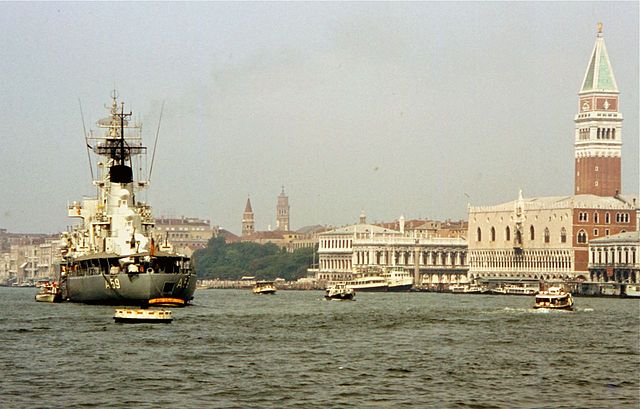
Deutschland in venice
In February-August 1978 she made another long cruise round the world, this time with officials and for state visits: She crossed the Med to the Suez Canal from Port Said, reached Bombay, called Port Kelang, Singapore, Manila, Tokyo. At this occasion, Federal President Walter Scheel accompanied by Foreign Minister Hans-Dietrich Genscher gave a grand reception aboard in Tokyo, hosting Emperor Hirohito. Later she departed for Apra Harbor, Apia and Nukuʻalofa, where King Taufaʻahau Tupou IV invited 100 crew members to a Tongan Feast and becama the guest of honor on board. She then sailed to Suva, Wellington, Fremantle and back via Colombo, the Suez Canal and Cádiz.
By April 1979 she made another Carribean cruise to Freetown, Port of Spain, Kingston, Guantanamo, Santo Domingo and Ponta Delgada. In June-August 1979 she made a northern cruise starting in Norway, Tromsø, the heading west to Reykjavik, calling Montreal, Thin Bridge, and back via Holy Cross of Tenerife and Dublin, for the first time. That same year, Federal Chancellor Helmut Schmidt was aboard, when she dropped anchor in Santo Domingo for a state reception.
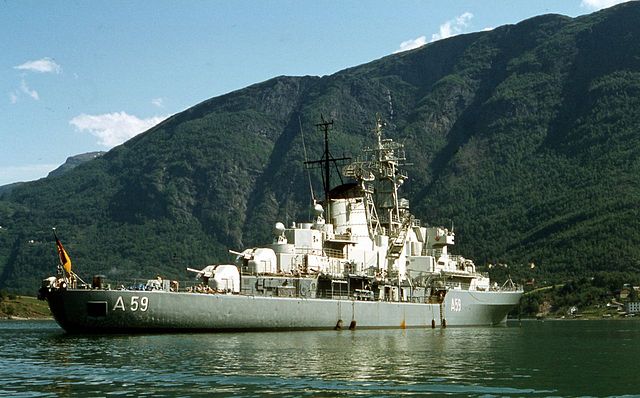
Deutschland in the Sognefjord, Norway
In April 1980 she made a short cruise in Piraeus, Istanbul, Rijeka and back via London and another in June-August to Bordeaux, Barcelona, Venice, and Lisbon. Captain Dieter Leonard took command in Oct. 1980 and stayed at post until 1983. 1981 saw her staying in home waters, with extensive drydock maintance, examination of all her equipments, modernization and overhaul. She made a short post-refit cruise in the north sea and Baltic. In March 1982 into May she resumed her cruises, via Ponta Delgada, Bridgetown, Kingston, crossed the Panama Canal to Guayaquil, Callao and back to Ponta Delgada. Federal President Karl Carstens was in Kingston for a state reception on board and later the President of Peru. By July-September 1982 she toured the Med, from Las Palmas, Tunis, Thessaloniki (first visit to Greece), Izmir and back via Algiers.
She made another long Asian cruise from March to August 1983 via the Suez Canal to Colombo, Chittagong, Jakarta, Singapore, Penang, Manila, Bangkok, and back to Colombo, Suez/Port Said, Kali Limenes and back to Kiel. Captain Wulf D. Plesmann took command that year and until 1986. In March-May 1984 she made another short cruise along the African West coast, via Las Palmas to Freetown, Abidjan, Lome, Libreville, and back via Abidjan, Dakar and Las Palmas. In July-September 1984 she made her north American Tour via Thin Bridge, Washington and Norfolk, being an honored Guest at the World’s Fair in New Orleans;
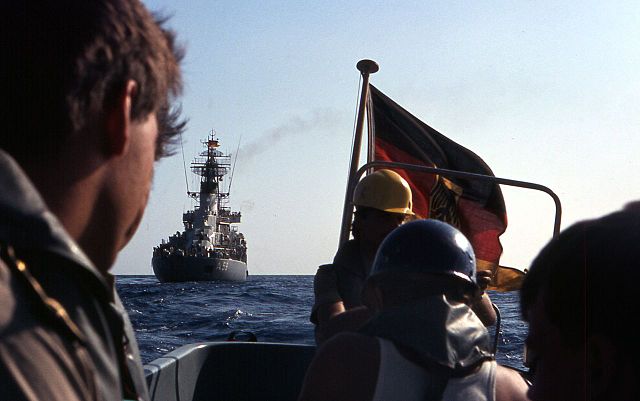
In Syrta, 1980s
By March-August 1986 she made another cruise between west africa and the Americas, via The Palms, Conakry, Abidjan, Montevideo, Buenos Aires, Rio de Janeiro, Belém and back. She Participated in the 100th anniversary of the Statue of Liberty. In April-September 1987 she started via the Med, Palermo, Suez, then Port Sudan, Madras, Singapore, Manila, Subic Bay, Incheon (first visit to Korea), Tokyo, Shanghai, Jakarta, Port Victoria, Mombasa an back via Port Said and Lisbon. Captain at sea Franz-Hermann Köhler took command that year, and was her last captain, until 1990. Federal Chancellor Helmut Kohl was on board while in Shanghai for this 1st visit of the Federal Navy to China. She also assisted the sinking MS Mimi K in April 17, 1987.
By March-June 1988 she made another America tour, via St. Croix of Tenerife, and Norfolk and in July-September, via Thin Bridge, Montreal and Saint-Laurent, Strom, Toronto, Detroit and Chicago via the great lakes (a first). In March-May 1989 she made another Med trip after a prolongated upkeep, via Alexandria, Istanbul, Pyrrhaus, Naples and back via Vigo, Spain. Her last cruise was in July–September 1989 and she sailed from Funchal to Edinburgh, Tromsø, Copenhagen and Kristiansand.
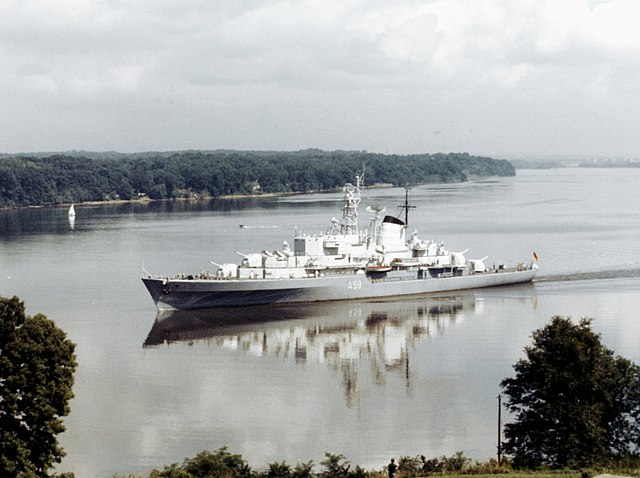
In the Potomac, 1984
Modernization prospects, decommission and fate
At that time, not only her electronics and armament were obsolete but despite these upkeeps she started to be worn out, especially the machinery. Replacement was on its way. She was also considered too large and expensive to maintain whereas the Bundersmarine was significantly decreased with the end of the cold war. Indeed, earlier than expected, decision was made in 1989 to decommission FGS Deutschland the next year, after 27 years of service. She no longer was the “mirror image of the fleet”. She could have been modernized to match new armaments and electronics standards, but at such a great cost in a period of budget cuts, that this was defeated by her annual operating costs and all the basic repairs needed, amounting for the examination commission to a staggering DM 40 million (EUR 20.4 million).
The training was taken over by destroyers, large enough for the task (the Lütjens class), in turn. The name was “freed”, and originally intended to be carried from the first F123-class frigate but lander names were chosen instead. It seems it will not be back for a time, unless the situation change, pehaps changed by the recent invasion of Ukraine and beefing up of the Bundesmarine. In October 1989, Deutschland was officially retired from service, decommissioned, with a sekeleton crew of 50 preparing her decommission.
She was laid up in the Arsenal of Wilhelmshaven with some considerations to preserve her as a museul ship, turning her ion the local Naval Museum. Other propositions were outlandish such as turning her into a hotel. However it was not done. The association responsible for funding her preservation never suceeed in her call, despite the federal government left her to use free of charge, but the costs were just too much. Decision was taken by the city’s mayot in December 27, 1993 to have the demilitarized ship sold for BU, purchased by Alang shipbreaking Co., beached after a long trip towed by the ocean-going tugboat Svetlomor 3 and a 80 days trip. One anchor remains today at the village square of Sengwarden.
Resources

Links
On deutschland-a59.de (site not accessible right now 28-09-22)
On die-marine.de
On deutschland-a59.jimdo.com
On deteringjuergen.jimdofree.com
pdf file on bundeswehr.de
on militaryfactory.com
Wiki (DE)
Books
Gardiner, Robert, ed. (1983). Conway’s All the World’s Fighting Ships 1947-1995, Conway
Schulschiff „Deutschland“ 1968. Sein Weg – aufgezeichnet nach den Tagebüchern des ehemaligen Kommandanten Karl H. Peter. Druckhaus Möller, Rendsburg.
Jürgen Rhades: Schulschiff Deutschland. Bernard & Graefe, Koblenz 1987
Gerhard Koop, Siegfried Breyer: Die Schiffe, Fahrzeuge und Flugzeuge der deutschen Marine von 1956 bis heute. Bernard & Graefe 1996
Hans H. Hildebrand, Albert Röhr, Hans-Otto Steinmetz: Die deutschen Kriegsschiffe. Mundus, Ratingen 1979
videos
Bundesmarine classic
Model Kits
Not a lot of choice unlike the other name-bearers, a WWI Transport U-Boat, later U151, the pre-dreadnought and interwar “pocket battleship” cruiser class. Only the (on scalemates.com) NNT Modell+Buch | No. 70023 | 1:700.
Parts on modellbau-lassek.de

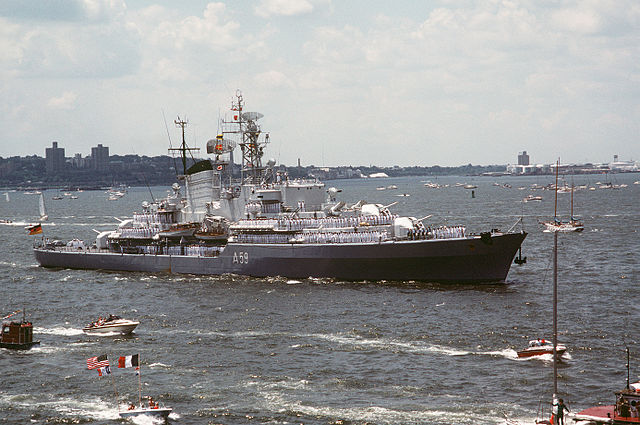

 Latest Facebook Entry -
Latest Facebook Entry -  X(Tweeter) Naval Encyclopedia's deck archive
X(Tweeter) Naval Encyclopedia's deck archive Instagram (@navalencyc)
Instagram (@navalencyc)





 French Navy
French Navy Royal Navy
Royal Navy Russian Navy
Russian Navy Armada Espanola
Armada Espanola Austrian Navy
Austrian Navy K.u.K. Kriegsmarine
K.u.K. Kriegsmarine Dansk Marine
Dansk Marine Nautiko Hellenon
Nautiko Hellenon Koninklije Marine 1870
Koninklije Marine 1870 Marinha do Brasil
Marinha do Brasil Osmanlı Donanması
Osmanlı Donanması Marina Do Peru
Marina Do Peru Marinha do Portugal
Marinha do Portugal Regia Marina 1870
Regia Marina 1870 Nihhon Kaigun 1870
Nihhon Kaigun 1870 Preußische Marine 1870
Preußische Marine 1870 Russkiy Flot 1870
Russkiy Flot 1870 Svenska marinen
Svenska marinen Søværnet
Søværnet Union Navy
Union Navy Confederate Navy
Confederate Navy Armada de Argentina
Armada de Argentina Imperial Chinese Navy
Imperial Chinese Navy Marinha do Portugal
Marinha do Portugal Mexico
Mexico Kaiserliche Marine
Kaiserliche Marine 1898 US Navy
1898 US Navy Sovietskiy Flot
Sovietskiy Flot Royal Canadian Navy
Royal Canadian Navy Royal Australian Navy
Royal Australian Navy RNZN Fleet
RNZN Fleet Chinese Navy 1937
Chinese Navy 1937 Kriegsmarine
Kriegsmarine Chilean Navy
Chilean Navy Danish Navy
Danish Navy Finnish Navy
Finnish Navy Hellenic Navy
Hellenic Navy Polish Navy
Polish Navy Romanian Navy
Romanian Navy Turkish Navy
Turkish Navy Royal Yugoslav Navy
Royal Yugoslav Navy Royal Thai Navy
Royal Thai Navy Minor Navies
Minor Navies Albania
Albania Austria
Austria Belgium
Belgium Columbia
Columbia Costa Rica
Costa Rica Cuba
Cuba Czechoslovakia
Czechoslovakia Dominican Republic
Dominican Republic Haiti
Haiti Hungary
Hungary Honduras
Honduras Estonia
Estonia Iceland
Iceland Eire
Eire Equador
Equador Iran
Iran Iraq
Iraq Latvia
Latvia Liberia
Liberia Lithuania
Lithuania Mandchukuo
Mandchukuo Morocco
Morocco Nicaragua
Nicaragua Persia
Persia San Salvador
San Salvador Sarawak
Sarawak Uruguay
Uruguay Venezuela
Venezuela Zanzibar
Zanzibar Warsaw Pact Navies
Warsaw Pact Navies Bulgaria
Bulgaria Hungary
Hungary

 Bundesmarine
Bundesmarine Dutch Navy
Dutch Navy Hellenic Navy
Hellenic Navy Marina Militare
Marina Militare Yugoslav Navy
Yugoslav Navy Chinese Navy
Chinese Navy Indian Navy
Indian Navy Indonesian Navy
Indonesian Navy JMSDF
JMSDF North Korean Navy
North Korean Navy Pakistani Navy
Pakistani Navy Philippines Navy
Philippines Navy ROKN
ROKN Rep. of Singapore Navy
Rep. of Singapore Navy Taiwanese Navy
Taiwanese Navy IDF Navy
IDF Navy Saudi Navy
Saudi Navy Royal New Zealand Navy
Royal New Zealand Navy Egyptian Navy
Egyptian Navy South African Navy
South African Navy






























 Ukrainian Navy
Ukrainian Navy dbodesign
dbodesign